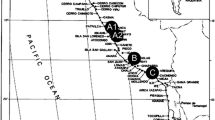Summary
Plants of seven perennial Trifolium species were interspecifically pollinated. The female flowers opened at 40 °C, and the male flowers opened in the greenhouse or field without a temperature treatment. T. pratense was pollinated with T. ambiguum, T. hirtum, T. ochroleucum, T. rubens, T. sarosiense, and T. medium. T. medium was pollinated with T. pratense. Seeds were obtained from all pollinations ; however, 86 of the progeny were morphologically and cytologically similar to their female parent, and probably resulted from self-fertilization. Many seeds of possible hybrid origin were small and/or did not germinate. Some seeds produced weak or albino seedlings which died at an early age. Excised pistils of T. medium from flowers that opened at 40 °C were more compatible with pollen of T. pratense than pistils of T. medium that developed in the field, indicating that the elevated temperature caused greater hybrid seed production than was observed in our earlier studies. The high temperature technique may prove useful in obtaining hybrids in Trifolium.
Zusammenfassung
In der Gattung Trifolium ist sowohl nach Selbstung als auch nach Artkreuzungen häufig Inkompatibilität zu beobachten. Es wird über Untersuchungen berichtet, durch Wärmebehandlung während der Blüte die Inkompatibilität zu überwinden.
Zu diesen Zweck wurden die Blüten der mütterlichen Eltern einer Temperatur von 40 °C ausgesetzt und danach mit Pollen von unbehandelten Pflanzen bestäubt, die auf dem Feld oder im Gewächshaus aufblühten: Trifolium pratense wurde mit T. ambiguum, T. hirtum, T. ochroleucum, T. rubens, T. sarosiense und T. medium bestäubt, T. medium mit T. pratense. Aus allen Bestäubungen wurden Samen erhalten. 86% der Nachkommen entsprachen jedoch morphologisch und cytologisch ihrem mütterlichen Elter und waren vermutlich das Ergebnis einer Selbstbefruchtung. Viele Samen, die möglicherweise aus Kreuzungen stammten, waren klein und/oder keimten nicht. Aus einigen Samen erwuchsen schwache oder albino-Sämlinge, die bald abstarben. Griffel von T. medium, die aus Blüten herausgelöst wurden, die sich bei 40 °C geöffnet hatten, waren für Pollen von T. pratense verträglicher als Griffel, die sich auf dem Felde entwickelten. Dieser Befund läßt den Schluß zu, daß die höhere Temperatur einen besseren Hybridsamenansatz bewirkt hat, als er in unseren früheren Untersuchungen beobachtet wurde. Eine Temperaturbehandlung kann sich demnach bei Trifolium für eine Erzeugung von Hybriden als günstig erweisen.
Similar content being viewed by others
Literature cited
Atwood, S. S.: The genetics of cross incompatibility among self-incompatible plants of Trifolium repens L. Agron. Jour. 32, 955–968 (1940).
Britten, E. J.: Chromosome numbers in the genus Trifolium. Cytologia 28 (4), 428–449 (1963a).
Britten, E. J.: Chromosome number of rose clover, Trifolium hirtum. Sci. 142, 401–402 (1963b).
Brooks, R. M., Bradley, M., Anderson, Th.: Plant microtechnique manual. Dept. Pomol. Univ. of Calif. 70 pp. (1963).
Cincura, F.: Cytotaxonomic analysis of Trifolium sarosiense. Biologica 20 (4): 300–305 (1965). (As reviewed in Biol. abst. 46, 1965).
Darlington, C. D., Janaki Ammal, E. K.: Chromosome Atlas of Cultivated Plants. London: George Allen and Unwin Ltd. 1945.
Dadson, R. D.: Interspecific hybridization between some perennial Trifolium species and T. pratense L. Unpublished Doctoral Thesis, McGill University, Montreal, Canada, 1969.
De Jong, D. W., Olsen, A. C., Hawker, K. M., Jansen, E. F.: Effect of cultivation temperature on peroxidase isozymes of plant cells grown in suspension. Plant Physiol. 43, 841–844 (1968).
Keim, W. F.: Interspecific hybridization in Trifolium utilizing embryo culture techniques. Agron. Jour. 45, 601–606 (1953).
Kendall, W. A.: Growth of Trifolium pratense L. pollen tubes in compatible and incompatible styles of excised pistils. Theoretical and Applied Genetics 38, 351–354 (1968).
Kendall, W. A., Taylor, N. L.: Effect of temperatures on Pseudo-self-compatibility in Trifolium pratense L. Theoretical and Applied Genetics 39, 123–126 (1969).
Leffel, R. C.: Pseudo-self-compatibility and segregation of gametophytic self-incompatibility alleles in red clover, Trifolium pratense L. Crop Sci. 3, 377–380 (1963).
Müller, Gertrud: Untersuchungen über das Pollenschlauchwachstum bei verschiedenen Trifolium-Artkreuzungen. Züchter 33, 11–17 (1960).
Pandey, K. K.: Origin of genetic variability: combinations of peroxidase isozymes determine multiple allelism of the S gene. Nature 18, 669–672 (1967).
Senn, H. A.: Chromosome numbers of Leguminosae. Bibliog. Genet. 12, 175–336 (1938).
Silow, R. A.: A preliminary report on pollen tube growth in red clover, T. pratense L. Welsh Plt. Breeding Sta. Bul., Series S 12, 228–240 (1931).
Taylor, N. L., Stroube, W. H., Collins, G. B., Kendall, W. A.: Interspecific hybridization of red clover (Trifolium pratense L.). Crop Sci. 3, 549–552 (1963).
Townsend, C. E.: Self-compatibility studies with diploid alsike clover, Trifolium hybridum L. III. Response to temperature. Crop Sci. 8, 269–272 (1968).
Williams, R. D.: Self- and cross-sterility in red clover. Welsh Plt. Breeding Sta. Bul., Series H. 12, 181–208 (1931).
Wit, F.: Chemically induced male sterility — a new tool in plant breeding ? Euphytica 9, 1–9 (1960).
Author information
Authors and Affiliations
Additional information
Communicated by R. W. Allard
Cooperative investigations of the Crops Research Division, Agricultural Research Service, U.S. Department of Agriculture and the Kentucky Agricultural Experiment Station. Part of a thesis submitted by the senior author in partial fulfillment of the requirements for the M.S. degree. This paper (No. 69-3-126) is published with permission of the Director, Kentucky Agricultural Experiment Station, Lexington, Ky. 40506.
Rights and permissions
About this article
Cite this article
Newton, D.L., Kendall, W.A. & Taylor, N.L. Hybridization of some Trifolium species through stylar temperature treatments. Theoret. Appl. Genetics 40, 59–62 (1970). https://doi.org/10.1007/BF00277271
Received:
Issue Date:
DOI: https://doi.org/10.1007/BF00277271




